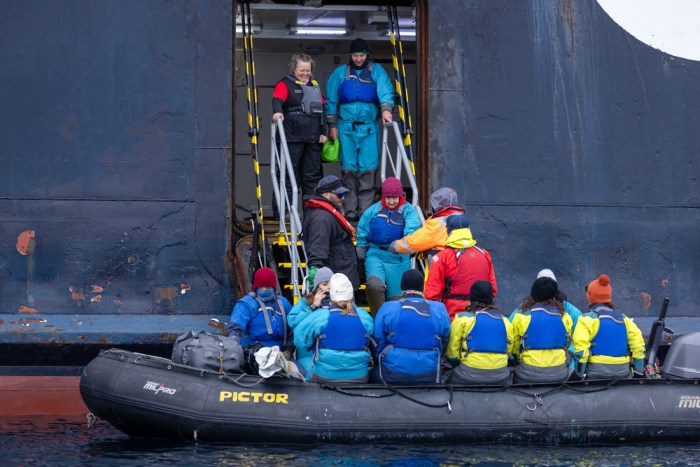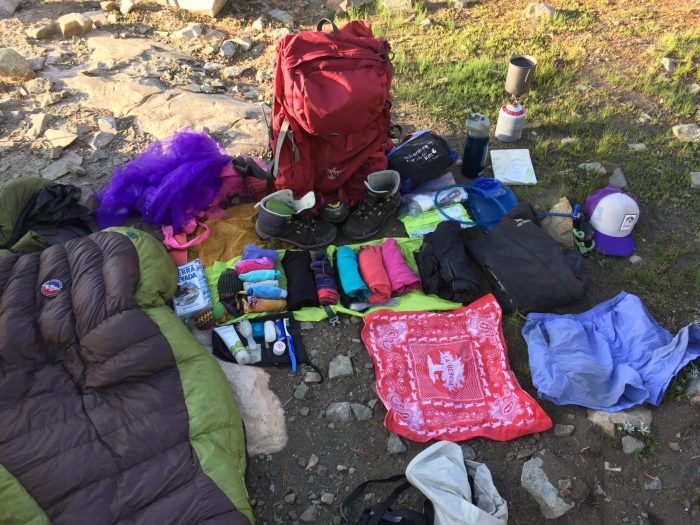Backpacking Packing List: Conquering the wilderness requires meticulous planning, and nothing is more crucial than a well-thought-out packing list. This isn’t just about stuffing your bag; it’s about strategic preparation for comfort, safety, and a truly unforgettable adventure. From selecting the right backpack and mastering efficient packing techniques to navigating unfamiliar terrain and ensuring your safety, this comprehensive guide will equip you with the knowledge to tackle any trail with confidence.
We’ll delve into essential gear, navigation tools, food and water management, and even hygiene tips, ensuring you’re ready for anything the wilderness throws your way. Get ready to transform your backpacking experience.
This guide covers everything from choosing the perfect boots and mastering layering techniques to creating a balanced meal plan and understanding crucial safety protocols. We’ll explore different packing methods, navigation tools, and first-aid essentials, providing actionable strategies for a smooth and enjoyable trip. We’ll also address common concerns like water purification, wildlife encounters, and maintaining hygiene in the backcountry, leaving no stone unturned in your quest for a successful backpacking adventure.
Essential Gear
Backpacking requires meticulous planning, and choosing the right clothing and footwear is paramount to a comfortable and successful trip. The wrong gear can lead to blisters, hypothermia, or simply an uncomfortable experience that detracts from the enjoyment of the wilderness. Prioritizing layering and selecting moisture-wicking fabrics are key to managing varying temperatures and staying dry. This section details essential clothing and footwear choices, providing a framework for building your own personalized packing list.
Backpacking Clothing Packing List
Creating a versatile clothing system for backpacking involves layering to adapt to changing weather conditions. This approach allows you to add or remove layers as needed, maintaining optimal comfort and preventing overheating or chilling. The following list provides a foundation, adaptable based on the specific climate and duration of your trip. Remember to prioritize lightweight, quick-drying, and durable fabrics.
- Base Layer (1-2 sets): Merino wool or synthetic (polypropylene) long-sleeve shirts and long underwear. These wick moisture away from your skin, keeping you dry and warm. Merino wool is naturally odor-resistant, a significant advantage on multi-day trips.
- Mid Layer (1-2 sets): Fleece jacket or lightweight down jacket for insulation. Fleece provides warmth and breathability, while down offers superior warmth-to-weight ratio, though it loses its insulating properties when wet. Consider a hybrid option combining both.
- Outer Layer (1): Waterproof and windproof jacket and pants. Look for breathable fabrics like Gore-Tex or similar technologies to prevent overheating while providing protection from the elements. These are crucial for unpredictable weather.
- Hiking Pants (1 pair): Durable, quick-drying hiking pants are essential. Consider convertible pants that zip off into shorts for warmer conditions.
- Shorts (1 pair): Lightweight and quick-drying shorts are useful for warmer days or around camp.
- Socks (3-4 pairs): Choose moisture-wicking hiking socks made of merino wool or synthetic materials. Avoid cotton socks, which retain moisture and can cause blisters.
- Underwear (3-4 pairs): Similar to socks, prioritize moisture-wicking materials.
- Hat (1): A wide-brimmed hat for sun protection and a warm beanie for colder conditions.
- Gloves (1 pair): Lightweight gloves or liners are helpful for colder weather.
Backpacking Boot Comparison, Backpacking Packing List
Choosing the right backpacking boots is critical for comfort and injury prevention. The ideal boot depends on the terrain you’ll be covering.
| Boot Type | Terrain Suitability | Pros | Cons |
|---|---|---|---|
| Lightweight Hiking Boots | Well-maintained trails, less technical terrain | Lightweight, comfortable for long distances on easier trails, breathable | Less ankle support, not suitable for rugged terrain or heavy loads |
| Mid-Cut Hiking Boots | Moderate terrain, some scrambling, varied trails | Good balance of support, weight, and comfort, suitable for carrying moderate weight | Can be heavier than lightweight boots, may not offer enough support for extremely rugged terrain |
| High-Cut Hiking Boots | Rugged terrain, technical trails, heavy loads | Excellent ankle support, protection from rocks and debris, suitable for heavy loads | Heavy, less breathable, can be less comfortable for long distances on easier trails |
| Trail Running Shoes | Smooth, well-maintained trails, minimal elevation gain | Lightweight, comfortable, breathable, good ground feel | Lack of ankle support, not suitable for rugged terrain, uneven surfaces, or carrying heavy loads |
Moisture-Wicking Fabrics
Moisture-wicking fabrics are engineered to draw sweat away from your skin, keeping you dry and comfortable. This is crucial in backpacking, where you’ll likely be sweating from exertion. Materials like merino wool and synthetics (polyester, polypropylene) excel at this, preventing the chilling effect of damp clothing and reducing the risk of chafing and blisters. Cotton, on the other hand, retains moisture, making it unsuitable for backpacking.
The difference between wearing moisture-wicking base layers and cotton can be significant, particularly in colder or wet conditions.
Backpacking Boot Care and Maintenance
Proper care extends the life of your backpacking boots and ensures optimal performance. After each hike, remove dirt and debris from your boots using a brush. Allow them to air dry completely, avoiding direct heat or sunlight which can damage the leather or synthetic materials. Condition leather boots regularly to maintain their flexibility and water resistance. For waterproof boots, apply a waterproofing spray as needed.
Regularly inspect your boots for wear and tear, addressing any issues promptly to prevent further damage. Replacing worn-out insoles can significantly improve comfort and support. Storing boots in a cool, dry place when not in use will also help to prolong their lifespan.
Backpack Selection & Packing Techniques: Backpacking Packing List

Choosing the right backpack and mastering efficient packing techniques are crucial for a comfortable and successful backpacking trip. A poorly chosen pack or inefficient packing can lead to discomfort, injury, and ultimately, a less enjoyable experience. This section will guide you through selecting the perfect backpack and employing proven packing strategies to maximize your comfort and efficiency on the trail.
Backpack Size, Weight, and Features
The ideal backpack size depends heavily on the length of your trip and the amount of gear you need to carry. For shorter trips (1-3 days), a 50-65 liter pack is generally sufficient. Longer trips (4+ days) will require a larger pack, often in the 65-85 liter range. However, remember that bigger doesn’t always mean better. A larger pack can tempt you to overpack, adding unnecessary weight and strain.
Prioritize lightweight materials like nylon or ripstop nylon. Features to consider include adjustable torso length for a proper fit, comfortable hip belt and shoulder straps for weight distribution, multiple compartments for organization, and durable, weather-resistant construction. A rain cover is a must-have accessory for any backpack. Consider packs with external attachment points for trekking poles, sleeping pads, and other items to improve weight distribution and accessibility.
Remember, every ounce counts, so weigh your pack before each trip to monitor your progress.
Comparison of Backpack Packing Methods
Two common methods are the “bear bag” method and the “stuff sack” method. The bear bag method involves suspending your food and scented items in a tree using a rope and bear bag, deterring animals. This method is essential in bear country to prevent wildlife encounters and protect your food. However, it requires extra equipment and time. The stuff sack method involves organizing items into separate stuff sacks based on their use (clothing, cooking, first aid, etc.).
This approach facilitates easier access to specific items while keeping the pack organized. It’s simpler than the bear bag method but less effective in preventing animal encounters. The choice between these methods depends on your location and the regulations of the area you are backpacking in.
Efficient Backpack Packing Strategies
Efficient packing involves strategic placement of items to optimize weight distribution and accessibility. Imagine your backpack as a three-dimensional space. Heavier items, such as your tent and sleeping bag, should be packed closest to your back and near the hip belt for stability and comfort. Lighter items, like clothing and toiletries, should be placed higher in the pack, keeping the center of gravity close to your body.
Frequently accessed items, such as your water bottle, first-aid kit, and snacks, should be in easily accessible pockets or the top compartment. Think of it like building a pyramid within your pack, with the heaviest items at the base and progressively lighter items stacked on top. Avoid leaving empty spaces; use smaller items to fill gaps and prevent shifting.
Adjusting Backpack Straps and Hip Belt
Proper adjustment of straps and hip belt is crucial for comfort and injury prevention. First, adjust the torso length so the pack sits comfortably on your back without pulling on your shoulders. Next, tighten the hip belt until it feels snug around your hips. The majority of your pack’s weight should rest on your hips, not your shoulders.
Adjust the shoulder straps to distribute weight evenly and prevent the pack from bouncing. The straps should be snug but not overly tight. Finally, adjust the sternum strap to further stabilize the pack and prevent shoulder strap slippage. Regularly check the adjustments throughout your trip, especially after significant changes in load. Proper adjustment is a key to preventing back pain and fatigue.
Navigation & Safety Equipment

Navigating unfamiliar terrain and ensuring your safety are paramount when backpacking. Proper equipment and preparedness can transform a challenging adventure into a rewarding experience, mitigating risks and maximizing enjoyment. Failing to plan is planning to fail, as the saying goes, and this is especially true in the wilderness. Let’s delve into the essential tools and strategies that will empower you to confidently explore the backcountry.
Essential Navigation Tools
Reliable navigation is crucial for staying on course and avoiding getting lost. A combination of tools provides redundancy and increases your chances of successfully navigating your backpacking trip, even if one device fails.
- Topographic Maps: These detailed maps illustrate terrain features like elevation, rivers, trails, and landmarks. Learning to interpret them is a fundamental skill for any backpacker. They’re invaluable for pre-trip planning and for navigating when electronic devices fail.
- Compass: A compass provides your bearing, indicating the direction you’re traveling relative to magnetic north. Knowing how to use a compass with a map (map and compass navigation) is crucial for accurate navigation, especially in areas with poor visibility or unreliable GPS signals. Practice this skill beforehand.
- GPS Device: A handheld GPS device offers precise location data, often including waypoints and route tracking capabilities. While helpful, remember that GPS devices rely on satellite signals, which can be unreliable in dense forests or canyons. Always have a backup navigation method.
- Altimeter: An altimeter measures elevation, assisting in route planning and navigation, particularly in mountainous terrain. It helps you track your ascent and descent, aiding in pacing and safety, especially when considering altitude sickness.
First-Aid Kit Essentials
A comprehensive first-aid kit is non-negotiable for any backpacking trip. The wilderness offers little in the way of immediate medical assistance, making self-sufficiency essential. The contents should be tailored to the specific trip, duration, and potential hazards.
- Wound Care: Sterile gauze pads, antiseptic wipes, bandages of various sizes, adhesive tape, antibiotic ointment.
- Pain Relief: Ibuprofen or acetaminophen for pain and fever reduction.
- Blister Treatment: Moleskin or blister pads to prevent and treat blisters.
- Antidiarrheal Medication: To manage gastrointestinal issues.
- Antihistamine: For allergic reactions.
- Tweezers and Scissors: For removing splinters or cutting bandages.
- Emergency Blanket: For warmth and protection from the elements.
Communication Plan
Effective communication is critical, especially in emergencies. Plan for various scenarios, acknowledging the limitations of cell service in remote areas.
- Share Your Itinerary: Inform a trusted friend or family member of your detailed itinerary, including your planned route, expected return time, and emergency contact information.
- Satellite Communicator (InRemote Areas): For areas with no cell service, a satellite messenger or personal locator beacon (PLB) allows for two-way communication or emergency SOS signals.
- Whistle: A loud whistle can signal for help over long distances.
- Emergency Contact Information: Keep emergency contact information readily accessible, both on your person and in a waterproof container.
Wildlife Encounter Safety Protocols
Wildlife encounters are a possibility in many backpacking areas. Preventative measures are key, but knowing how to respond to unexpected encounters is equally crucial.
- Food Storage: Store food and scented items in bear canisters or hung properly to avoid attracting animals.
- Noise Awareness: Make noise while hiking to avoid surprising animals. This is particularly important in areas with bears or other large predators.
- Maintain Distance: Observe wildlife from a safe distance; never approach or feed them.
- Bear Spray: Carry bear spray and know how to use it effectively. This is a crucial deterrent in bear country.
- Response Strategies: If confronted by a wild animal, follow established guidelines for that specific animal. This might involve slowly backing away, making yourself appear large, or using bear spray (if applicable and trained). Avoid direct eye contact and never run.
Mastering the art of backpacking packing is a journey in itself – a journey towards preparedness, efficiency, and ultimately, a deeper connection with nature. This guide has provided a framework for planning your backpacking trip, equipping you with the knowledge and tools to navigate any challenge. Remember, the key to a successful trip lies not only in what you pack but also in how you pack it and the confidence you carry with you.
So, pack smart, pack light, and pack your bags with adventure! Embrace the challenge, and let the wilderness inspire you.

